
Europe and Mediterranean: Scandinavian Solar Eclipse with Greenland & Scotland Cruise
Holland America Line
Marvel at the magic of the solar eclipse from a spectacular vantage point. Other highlights include: Iceland's crystal fjords, Greenland's stark beauty and an Edinburgh overnight.

Executive Member Benefit
Executive Members receive an annual 2% Reward, up to $1,250, on qualified Costco Travel purchases
Digital Costco Shop Card
Member Exclusive: Digital Costco Shop Card with every Holland America Line sailing†
Sailing Itinerary

Note: Cruise itineraries are subject to change. Please verify ports and times directly with the cruise line.
Overview
Nowadays Rotterdam is a vital part of the economy of the Netherlands. The Port of Rotterdam, the largest port in the world with a total throughput of about 300 million metric tons a year provides a solid base for industry in and around the Rotterdam area. Its population is about 575000, which makes it one of the largest cities in the Netherlands, but the number of people that work in the Rotterdam area or are otherwise economically dependent on it exceeds that number by far. The density of the population is among the highest in the Netherlands, exceeding 4000 per square kilometer. Shipping, storage, and forwarding are of course among the most important activities in the region, but the port of Rotterdam has also created a large chemical industry, which is fully dependent upon the transport facilities for the inflow of crude oil and the shipping of the various refined end products. Large petrochemical plants have sprung up, especially on the south bank of the Maas. These plants are in operation 24 hours a day. The development of Europoort ('Euro gate') started in 1957. A large complex of ports and industrial areas was created between Rotterdam and the entry to the North Sea. When more space was needed, the Maasvlakte ('Maas Flats') was created. Using dikes, dams, and sand deposits the coastline was altered to include many square kilometers of newly created land, where the Petroleum Harbors, container terminals, ore terminals, and the Maasvlakte power plant are located. An interesting feature is the 'disaster area', a training complex where fire brigades train to cope with large-scale industrial accidents. The complex includes a grounded tanker that is set on fire several times a day. The name Europoort suggests that Rotterdam wanted to become the gateway to Europe. By 1963 this suggestion had become outdated because in that year Rotterdam could claim to be the largest port in the world, a record that it still holds. The Berge Stahl, a 365,000-ton ore carrier, is fully dependent on the port of Rotterdam since this is the only port on the European continent that this ship (with its 23m/75ft draught) can access. After the flood in 1953, a large project was initiated to prevent such floodings in the future. This project, the 'Delta plan', involved stronger and higher dikes and numerous flood barriers. The latest of those flood barriers to be completed was the storm surge barrier in the Nieuwe Waterweg near Hoek van Holland. Two enormous doors mounted on swing arms can be used to close off the Nieuwe Waterweg, should storm and high water require so to protect the country from flooding. Normally the doors are open, so as not to impede the flow of ships through the Nieuwe Waterweg. Building and development have become a way of life for Rotterdam. The city has continued to grow, and it shows no signs of slowing down. And although this constant increase in population, urbanization, and development all breed their problems, Rotterdam is ready for the next millennium. As the economic heart of the Netherlands, with a population heading towards 600000, it had better be ready.
Overview
Kristiansand is a city in southern Norway. Its old town, Posebyen, features traditional wooden houses. In the center, the neo-Gothic Kristiansand Cathedral is near the Sørlandets Museum, which displays Norwegian art from 1800 to today. The southeastern shoreline includes the Bystranda city beach, the 17th-century Christiansholm Fortress rotunda, and Fiskebrygga quay, lined with fishmongers selling their catch.
Overview
The beautiful village of Eidfjord is situated at the mouth of the Ejo River at the head of the Eifjord, an arm of the great Hardangerfjord. Behind the village, there are gravel and sand terraces which are 9000-year-old deposits left behind when the great inland ice melted and retreated. Possibly one of Norway's best-known waterfalls, the Vosingfoss, plunges into the Mabodal Canyon from the brink of the Hardanger plateau.
Overview
Hardanger is a name that Norwegians associate with blossom and fruit. In truth the orchard of Norway! Who would believe that you can grow apples, pears, plums, and even cherries at 60° north? A mild and pleasant climate and clear, light summer nights are ideal for our guests, as well as for fruit and berries. In the center of the district is the Hardangerfjord. High up you enter the Hardangervidda National Park and two of Norway’s largest glaciers, Folgefonna and Hardangerjokulen. From mountains and glaciers the majestic waterfalls foam down into the queen of fjords. This is Hardanger - a mixture of cold and warm, wilderness and quiet idylls, of old traditions and modern times!
Overview
Stavanger, the oil capital of Norway, is a medieval city. Although it didn't gain city status until 1125 when construction of the beautiful medieval cathedral began, the area has been populated for over 10,000 years. The city is an exciting combination of old and new. Narrow lanes and white timber houses are all in well-preserved traditional style, from classic style to funky. It is a modern city with a wide variety of shops, cafes and restaurants. Contrast characterizes this city, the people who live there, the surrounding landscape - and the weather! All this makes Stavanger a pleasant city.Stavanger is also the center of higher education in Rogaland County. It has several cultural institutions including international, British, and French schools because of the great influx of foreigners connected to the oil industry and the "Emigration Centre for Genealogical Studies and Contact Between Norway and North America". The Canning Museum is the only one of its kind in the world and testifies to what has been an important industry for Stavanger. Among the many other attractions are the theatre and the symphonic orchestra that has its home in the beautifully situated Kulturhuset.
Overview
Seyðisfjörður is a town in the Eastern Region of Iceland at the innermost point of the fjord of the same name. The town is located in the municipality of Múlaþing. A road over Fjarðarheiði mountain pass connects Seyðisfjörður to the rest of Iceland; 27 kilometres to the Ring Road and Egilsstaðir.
Overview
Seyðisfjörður is a town in the Eastern Region of Iceland at the innermost point of the fjord of the same name. The town is located in the municipality of Múlaþing. A road over Fjarðarheiði mountain pass connects Seyðisfjörður to the rest of Iceland; 27 kilometres to the Ring Road and Egilsstaðir.
Overview
Djupivogur is a small town and municipality located on a peninsula in the Austurland in eastern Iceland, near the island of Papey and on the fjord Berufjorour.
Overview
The Breidafjordur is a vast shallow bay on the west coast of Iceland between the wilderness of the North-West Peninsula to the north and the Snaefellsnes to the south. The bay has numerous islands with grassland and marshes and extensive intertidal areas along its deeply indented coastline. Snaefellsnes is a long and narrow peninsula with rocky sandstone cliffs holding important seabird colonies on the southern side and rocky shores and sandy lagoons on the coast of the bat to the north. The Breidafjordur is famous as the last resort of most of Iceland's remaining White-tailed Eagles and the islands of the bay support a few pairs of Grey Phalarope, a very rare breeding bird in the Western Palearctic. Harlequin Duck, an Icelandic speciality, can be seen both within the bay and on the southern side of the Snaefellsnes. Gyrfalcon breeds on the peninsula and the seabird colonies include Shag and Cormorant, Black, Common and Brunnich's Guillemot, Razorbill and Puffin, Glaucous Gull and Fulmar. Divers, Whooper Swan, Greylag Goose, Scaup, Long-tailed Duck and Eider also breed as well as Arctic Skua and Arctic Tern, Ptarmigan and Snow Bunting. Red-necked Phalarope, Purple Sandpiper, Whimbrel and Golden Plover are among the waders present in summer. Brent Goose occurs on passage and huge numbers of Knot and other waders visit the intertidal areas on migration. Iceland Gull is present in winter. Common and Grey Seals are commonly seen and in recent years the area has become an important base for whale-watching trips. These can be arranged at either Stykkisholmur or Olafsvik on the northern coast of the peninsula and cetaceans to be seen include White-beaked Dolphin, Killer and Pilot Whales with the possibility of Sperm and Humpback, Fin, Sei, Minke and even Blue Whales on the longer trips. There are roads around the perimeter and across the centre of the peninsula and also along the shore of the Breidafjordur enabling the entire area to be easily explored and there is regular public transport from Reykjavik. Accommodation is available in Stykkisholmur, Borganes and elsewhere and camping is possible at Olafsvik. There are regular boats across the bay from Stykkisholmur to Brjanslaekur on the North-West Peninsula which stop at some of the many islands including Flatey which has breeding Grey Phalarope and Black Guillemot.
Overview
Akureyri is a city at the base of Eyjafjorour Fjord in northern Iceland. In the center, the 1940 Akureyri Church has stained-glass windows portraying scenes from Icelandic Christian history. There are views of the fjord from the forecourt. Nearby, the Akureyri Art Museum displays contemporary art from Iceland and farther afield. To the south are the Botanical Gardens, with specimens from across Iceland.
Overview
Eyjafjordur is one of the longest fjords in Iceland. It is located in the central north of the country. Situated by the fjord is the country's fourth most populous municipality, Akureyri.
Overview
Ísafjörður is a town in the Westfjords region of northwest Iceland. It's known for its dramatic landscapes. The old town has wooden houses with corrugated tin roofs built by fishing merchants in the 18th and 19th centuries. The Westfjords Heritage Museum has exhibits on the town’s maritime history, including a collection of old fishing boats. The old hospital, now a cultural center, contains archives and photography.
Overview
Grundarfjörður is a town in the north of the Snæfellsnes peninsula in the west of Iceland. It is situated between a mountain range and the sea. The nearby mountain Kirkjufell forms a small peninsula.
Overview
The town of Paamiut is located at the mouth of the Kuannersooq Fjord and the town's name also means 'inhabitants at the mouth'. The town was built in 1742, and the very characteristic wooden church dates from 1909. The interesting local museum located at the town center is fitted up in 19th-century buildings that include a former carpentry workshop and a salt house. To all appearances, the area has been inhabited since around 1,500 BC. Like the other towns of West Greenland, the sea does not freeze over during winter and the primary occupation for the 2,100 inhabitants in Paamiut and its only settlement of Arsuk is fishing. In spring and summer however, the fishing and other maritime traffic can be obstructed by field ice floating along the east coast of Greenland and continuing up the west coast - but even so, the field ice is a fascinating sight. The sea's great importance to the town is also emphasized by the fact that Greenland's maritime trade training programs are housed here. Perhaps Paamiut ought to have been called 'the land of the white-tailed eagle' because the area has the largest population of white-tailed eagles in Greenland. If visitors choose to sail out on the open sea instead, they are almost certain to see whales in late summer and autumn. The whales will usually be rorquals, fin whales, killer whales, or humpbacks.
Overview
Nuuk was founded by the unfailingly optimistic Hans Egede - the Danish missionary with soul conversions on his agenda - who promptly named the settlement Good Hope. The naming turned out to be more of a Hail Mary than a prophecy: first, the native Inuit moved out of a neighborhood that, to their way of thinking, had become too congested, and later smallpox and tuberculosis epidemics ripped through the small settlement. Even today Nuuk is small by modern standards, with a total population of only 14,000. Despite a wealth of land and a paucity of people, Nuuk has insisted on housing the population in immense apartment blocks with imaginative names like Blok P - a kind of Gulag on ice - and the urban sprawl is now spreading out along the road to the airport. Kolonihavnen is a pleasant exception to the rest of Nuuk's Lego-city look: it's a picturesque 18th-century fishing village in the heart of Nuuk and gives some idea of what the town looked like before the industrial harbor was built. Nuuk's real attraction lies in its proximity to any number of excellent day hikes into the hinterland and the fabulous views from the tops of the nearby mountains. Organized tours, boat trips, and the rental of equipmentares also easier from the capital.
Overview
Nanortalik is close to the southwestern tip of Greenland at the mouth of several fjords, south of Qaqortoq. Sites of interest include the colonial quarter of the town amid the surrounding fjord and mountains. Tourists can witness the imposing granite peaks and spires of the Nunaap Isua (Cape Farewell) and Tasermiut Fjord regions, where the scenery is spectacular.
Overview
Qaqortoq, sitting at the tip of the peninsula in the south of Greenland, is a clean pleasant harbor town built on the site of Hans Egede's search for the lost colonists. Although only boasting 3500 people, it's considered the hub of the south and is worth visiting in summer when the place explodes with wildflowers. The town's pride of possession is the town square fountain - the only one in Greenland - with the names of the town burghers, past and present, in brass letters on the base (although many names have fallen victim to souvenir hunters). Qaqortoq Museum is worth a gander - it's one of Greenland's finest - and exhibits artifacts from past and present cultures. Mostly, though, Qaqortoq is used as a base for hiking treks: either one-day hikes up 'Peter's Cairn’ or around the edge of the Tasersuaq Lake, or as a departure point for the three- to four-day treks to the neighboring town of Igaliku. The Hvalsey ruins, sitting on a coastal strip just out of Qaqortoq, are Greenland's most extensive and best-preserved Norse ruins. There is a choice of ferry services on most days of the week, and several daily flights to other settlements along the west coast. It's also possible to trek from some of the neighboring towns. Qaqortoq is 450km (279 mi) down the coast from Nuuk, although the distance by foot would be much greater given the heavily fringed coastline.
Overview
Heimaey, literally Home Island, is an Icelandic island. At 13.4 square kilometers, it is the largest island in the Vestmannaeyjar archipelago and the largest and most populated island off the Icelandic coast.
Overview
Iceland's capital and largest city, Reykjavik, is on the coast. The city is home to the National and Saga museums, which trace Iceland’s Viking history. The striking concrete Hallgrimskirkja church and rotating Perlan glass dome offer sweeping views of the sea and nearby hills. Near the village of Grindavik, the geothermal Blue Lagoon spa exemplifies the island’s volcanic activity.
Overview
Runavík is a comparatively urbanized village in Runavík Municipality, Faroe Islands. It lies on the south half of the isle of Eysturoy.
Overview
Stornoway is the main town and the largest of the Outer Hebrides and the capital of Lewis and Harris in Scotland. The town's population is around 6,953, making it the third-largest island town in Scotland after Kirkwall in Orkney and Lerwick in Shetland.
Overview
Invergordon is a town whose history stretches back through two World Wars and has now developed into a centre for oilrig refurbishment and maintenance. It is also a major port of call for cruise liners, being the only deep water port in the area, 40 liners, with 21,000 visitors from all over the world, berthed in 2004. Ideally situated in the centre of the eastern Highlands, the town's High Street has recently been given a facelift with coloured granite blocks, speed controllers, a new restaurant and a mural has been painted on the Albyn Housing building. There are many places to eat, providing quick take-away food right through to a quality country house hotel and restaurant just inland from the town, Indian and Chinese food is also available as an alternative to the more traditional fayre. There is an Arts Centre, a Leisure and Sports Club, with a swimming pool and an 18-hole golf course on the outskirts of town.
Overview
South Queensferry is situated 8 miles west of Edinburgh, on the banks of the Forth Estuary. Its name is thought to have originated from the frequent journeys made by Queen Margaret of Scotland from Dunfermline, in Fife, south to over the estuary towards Edinburgh, in the late 11th century. The burgh prospered and was a leading seaport in the 16th century, as well as being the southern ferry port for the crossings to and from Fife. The town expanded even more in the 1880s during the construction of the Forth Rail Bridge, with a workforce of around 3000. The Navy established a base at the adjacent Port Edgar during the 1st World War. The other famous Forth Bridge, the Road Bridge, was constructed during the 1960s.The central part of the town is still quite old-fashioned and retained much of its charm as a protected area. At the western end of Main Street stands the Jubilee Tower, to commemorate the 50th year of Queen Victoria's reign. The Hawes Inn lies at the other end of the main street. The Inn has quite a literary heritage. The Scottish novelist, Walter Scott, described the inn in "Antiquary" and Robert Louis Stevenson, another Scottish author, is said to have found the inspiration for his novel "Kidnapped" while a guest at the inn. There is also a 200-year-old yew tree in the garden of the inn.South Queensferry is pleasant to visit for a stroll along the main street and to admire the spectacular views of the bridges. In the Summer months, tourists can take a ferry to the nearby Inchcolm Island. The town has a good selection of coffee shops and restaurants, several with good views. It can be reached by train from Edinburgh in a few minutes and is around a half-hour drive from my hometown of Stirling.
Overview
South Queensferry is situated 8 miles west of Edinburgh, on the banks of the Forth Estuary. Its name is thought to have originated from the frequent journeys made by Queen Margaret of Scotland from Dunfermline, in Fife, south to over the estuary towards Edinburgh, in the late 11th century. The burgh prospered and was a leading seaport in the 16th century, as well as being the southern ferry port for the crossings to and from Fife. The town expanded even more in the 1880s during the construction of the Forth Rail Bridge, with a workforce of around 3000. The Navy established a base at the adjacent Port Edgar during the 1st World War. The other famous Forth Bridge, the Road Bridge, was constructed during the 1960s.The central part of the town is still quite old-fashioned and retained much of its charm as a protected area. At the western end of Main Street stands the Jubilee Tower, to commemorate the 50th year of Queen Victoria's reign. The Hawes Inn lies at the other end of the main street. The Inn has quite a literary heritage. The Scottish novelist, Walter Scott, described the inn in "Antiquary" and Robert Louis Stevenson, another Scottish author, is said to have found the inspiration for his novel "Kidnapped" while a guest at the inn. There is also a 200-year-old yew tree in the garden of the inn.South Queensferry is pleasant to visit for a stroll along the main street and to admire the spectacular views of the bridges. In the Summer months, tourists can take a ferry to the nearby Inchcolm Island. The town has a good selection of coffee shops and restaurants, several with good views. It can be reached by train from Edinburgh in a few minutes and is around a half-hour drive from my hometown of Stirling.
Overview
Dover is one of the most-visited towns in England but most of the 13 million people who travel to Dover each year are bound for one of the many ferries, catamarans or hydrofoils that cross the English Channel (more properly called the Dover Straits) to North-West France. A small number of travellers stop in the town and enjoy the 'Dover hospitality' that is on offer. There is information on these pages for people travelling into Dover by road/rail/cycle and for those wanting to take a ferry to France, including Port & Ferry News. Drivers will see very little of Dover itself as they enter on either the A20 from the South or the A2 from the North-West. In both cases, the roads arrive at the Harbour, where they join. The whole of Dover's town stretches inland from the Harbour and continues along three valleys into the Kent countryside. Dover is at one end of the North Downs and has several ranges of hills, two of which have fortresses dating from the medieval and Roman eras, as well as more modern (19th Century) times. Behind the town centre are the modern-day barracks, Dover's past and current commitments to the country have always included more than can be seen under the famous White Cliffs. Modern-day Dover has a mixed economy but is still very heavily dependent on the ferry industry. Other major employers include: the Ministry of Defence (at Connaught Barracks), numerous freight companies, vehicle sellers & repairers! The history of Dover is best covered in the many books and videos on the subject (available, of course, at the town's Museum!).
Overview
Nowadays Rotterdam is a vital part of the economy of the Netherlands. The Port of Rotterdam, the largest port in the world with a total throughput of about 300 million metric tons a year provides a solid base for industry in and around the Rotterdam area. Its population is about 575000, which makes it one of the largest cities in the Netherlands, but the number of people that work in the Rotterdam area or are otherwise economically dependent on it exceeds that number by far. The density of the population is among the highest in the Netherlands, exceeding 4000 per square kilometer. Shipping, storage, and forwarding are of course among the most important activities in the region, but the port of Rotterdam has also created a large chemical industry, which is fully dependent upon the transport facilities for the inflow of crude oil and the shipping of the various refined end products. Large petrochemical plants have sprung up, especially on the south bank of the Maas. These plants are in operation 24 hours a day. The development of Europoort ('Euro gate') started in 1957. A large complex of ports and industrial areas was created between Rotterdam and the entry to the North Sea. When more space was needed, the Maasvlakte ('Maas Flats') was created. Using dikes, dams, and sand deposits the coastline was altered to include many square kilometers of newly created land, where the Petroleum Harbors, container terminals, ore terminals, and the Maasvlakte power plant are located. An interesting feature is the 'disaster area', a training complex where fire brigades train to cope with large-scale industrial accidents. The complex includes a grounded tanker that is set on fire several times a day. The name Europoort suggests that Rotterdam wanted to become the gateway to Europe. By 1963 this suggestion had become outdated because in that year Rotterdam could claim to be the largest port in the world, a record that it still holds. The Berge Stahl, a 365,000-ton ore carrier, is fully dependent on the port of Rotterdam since this is the only port on the European continent that this ship (with its 23m/75ft draught) can access. After the flood in 1953, a large project was initiated to prevent such floodings in the future. This project, the 'Delta plan', involved stronger and higher dikes and numerous flood barriers. The latest of those flood barriers to be completed was the storm surge barrier in the Nieuwe Waterweg near Hoek van Holland. Two enormous doors mounted on swing arms can be used to close off the Nieuwe Waterweg, should storm and high water require so to protect the country from flooding. Normally the doors are open, so as not to impede the flow of ships through the Nieuwe Waterweg. Building and development have become a way of life for Rotterdam. The city has continued to grow, and it shows no signs of slowing down. And although this constant increase in population, urbanization, and development all breed their problems, Rotterdam is ready for the next millennium. As the economic heart of the Netherlands, with a population heading towards 600000, it had better be ready.
Onboard the Nieuw Statendam
Nieuw Statendam
Year Built: 2017
Honoring Holland America Line's past while keeping its eyes on the future, Nieuw Statendam is the sixth ship in Holland America Line’s history to bear the name Statendam and features several of the innovative venues that were introduced on her sister ship, the Koningsdam.
Activities & Services (included in cruise)
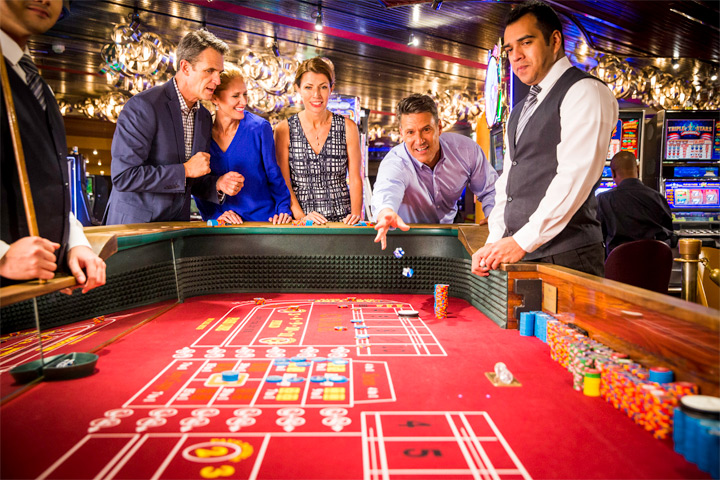
Casino
- Casino
- Fitness Center
- Culinary Arts Center
- Pool - Outdoor
- Pool - Indoor/Covered
- Sports Facilities
- Whirlpool/Jacuzzi
- Bars/Lounges
- Organized Age Specific Activities
- Teen Programs
- Concierge Desk
- Elevators
- Safe Deposit Boxes
Activities & Services (available for an extra fee)
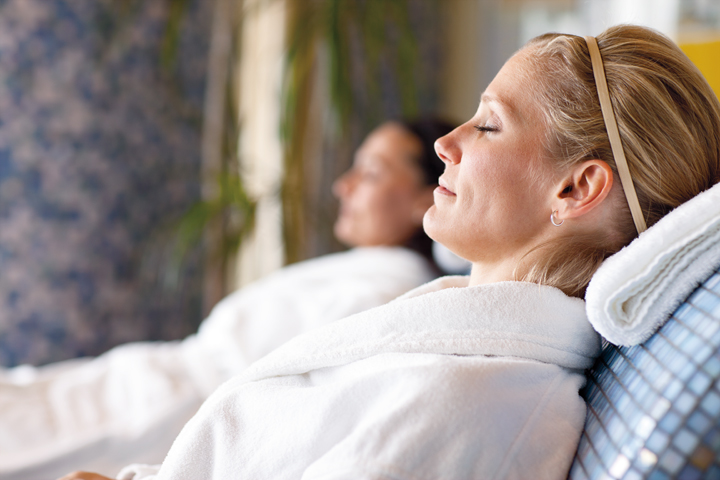
Greenhouse Spa
- Full-Service Spa
- Spa Services/Massage
- Dry Cleaning/ Laundry Service
- Duty-Free Shops/Boutiques
- Infirmary/Medical Center
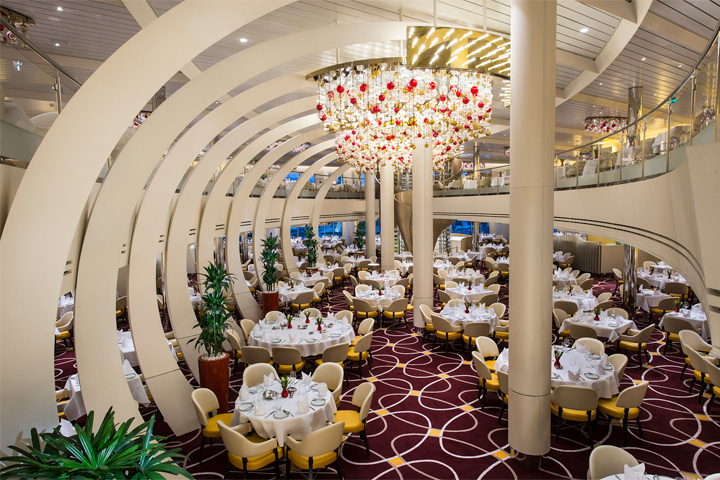
The Dining Room
Main Dining
The Dining Room: For breakfast, lunch or an unforgettable five-course dinner, the elegant main Dining Room is your destination for sophisticated dining, with menu selections from classic favorites to vegetarian options, to dishes inspired by the regions you’ll visit. Menus by Holland America Line's Culinary Council® of world-renowned chefs.
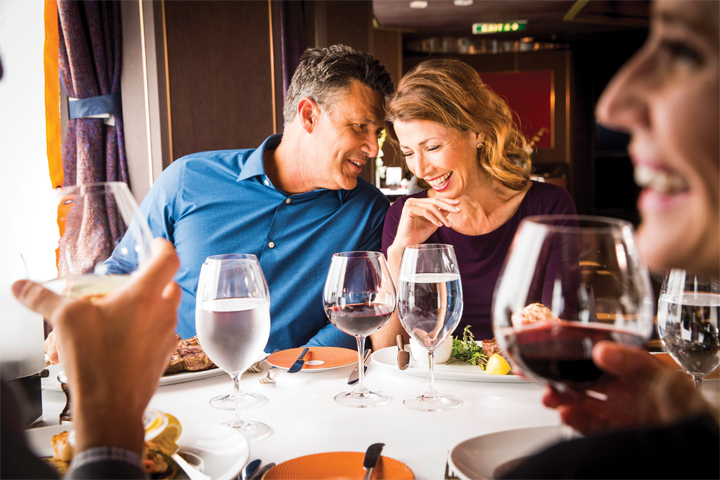
Pinnacle Grill
Specialty Dining
Pinnacle Grill: Enjoy dishes inspired by America’s Pacific Northwest, such as king salmon from Alaska and choice, responsibly raised beef from Washington State’s Double R Ranch. Complement your meal with a selection of boutique wines from the Pacific Northwest and other celebrated vineyards from around the world. This restaurant is available for an additional cost.
Canaletto: This authentic Italian restaurant offers a menu that celebrates spartire (Italian for "sharing"). Try Braised Chicken Cacciatore "al Forno," Branzino ai Ferri or a classic Italian pasta: spaghetti pomodoro or garlic shrimp-infused ravioli, perhaps. Buon appetito! This restaurant is available for an additional cost.
Tamarind: Tamarind delights diners with exotic menus evoking the culinary traditions of Southeast Asia, China and Japan. Recently noted by Condé Nast Traveler for its “cuisine that rivals the top restaurants on land,” Tamarind is located on the uppermost deck, providing stunning panoramic views. Lunch includes tantalizing items such as steamed dim sum and spicy crab. Exotic dinner menus created by Master Chef Rudi Sodamin feature dishes honoring the elements of water, wood, fire and earth. This restaurant is available for an additional cost.
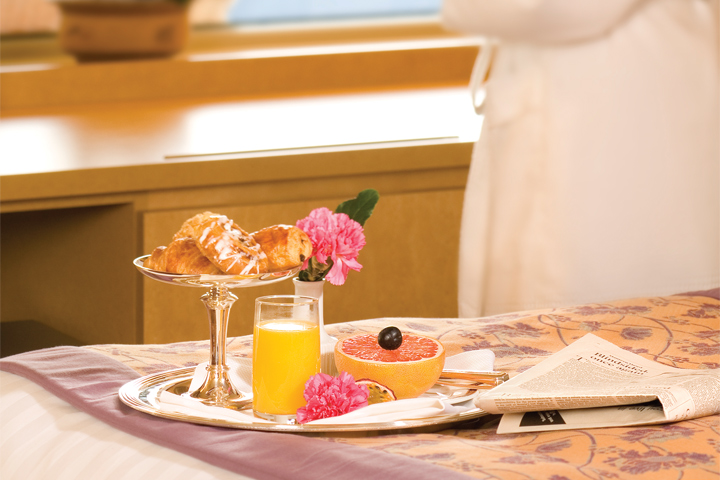
Room Service
Casual Dining
Lido Market: Lido Market provides a fresh, new approach to casual dining for breakfast, lunch or dinner, with a panoramic view of the sea. A modern marketplace with different themed stations, the Lido offers a curated selection of delicious options to grab on the go or to have quickly made to order.
Dive-In: Dive in to a grilled burger on brioche or a Nathan’s Famous gourmet hot dog. For alfresco dining by the pool, Dive-In has it all, including lighter fare like the grilled chicken breast sandwich and vegetarian-friendly portabella mushroom stack.
New York Pizza: Crisp Italian salads and personal pan pizzas made with a thin crust and a savory sauce are served up poolside.
Explorations Café: A comfortable, coffeehouse environment offering espresso drinks and pastries. This restaurant is available for an additional cost.
Grand Dutch Café: Inspired by blue and white Delftware, the Grand Dutch Café is the place to enjoy a fine pale lager or favorite coffee beverage with a traditional Dutch snack. This restaurant is available for an additional cost.
Room Service: Complimentary 24-hour dining in the comfort of your stateroom.
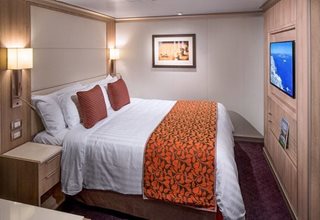
Category: IQ
Amenities- Daily housekeeping
- Complimentary 24-hour room service
- Elemis Aromapure soap, lotion, shampoo
- Luxurious bathrobes
- Generous storage
- Fresh fruit upon request
- Safe
- Ice service
- Shoeshine
- TV with On Demand movies, programming

Category: I
Amenities- Daily housekeeping
- Complimentary 24-hour room service
- Elemis Aromapure soap, lotion, shampoo
- Luxurious bathrobes
- Generous storage
- Fresh fruit upon request
- Safe
- Ice service
- Shoeshine
- TV with On Demand movies, programming

Category: J
Amenities- Daily housekeeping
- Complimentary 24-hour room service
- Elemis Aromapure soap, lotion, shampoo
- Luxurious bathrobes
- Generous storage
- Fresh fruit upon request
- Safe
- Ice service
- Shoeshine
- TV with On Demand movies, programming

Category: K
Amenities- Daily housekeeping
- Complimentary 24-hour room service
- Elemis Aromapure soap, lotion, shampoo
- Luxurious bathrobes
- Generous storage
- Fresh fruit upon request
- Safe
- Ice service
- Shoeshine
- TV with On Demand movies, programming

Category: L
Amenities- Daily housekeeping
- Complimentary 24-hour room service
- Elemis Aromapure soap, lotion, shampoo
- Luxurious bathrobes
- Generous storage
- Fresh fruit upon request
- Safe
- Ice service
- Shoeshine
- TV with On Demand movies, programming

Category: N
Amenities- Daily housekeeping
- Complimentary 24-hour room service
- Elemis Aromapure soap, lotion, shampoo
- Luxurious bathrobes
- Generous storage
- Fresh fruit upon request
- Safe
- Ice service
- Shoeshine
- TV with On Demand movies, programming
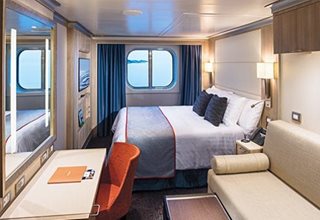
Category: FA
Amenities- Daily housekeeping
- Complimentary 24-hour room service
- Elemis Aromapure soap, lotion, shampoo
- Luxurious bathrobes
- Hair dryers, makeup mirrors
- Fresh fruit upon request
- Safe
- Ice service
- Shoeshine
- TV with On Demand movies, programming

Category: FB
Amenities- Daily housekeeping
- Complimentary 24-hour room service
- Elemis Aromapure soap, lotion, shampoo
- Luxurious bathrobes
- Hair dryers, makeup mirrors
- Fresh fruit upon request
- Safe
- Ice service
- Shoeshine
- TV with On Demand movies, programming
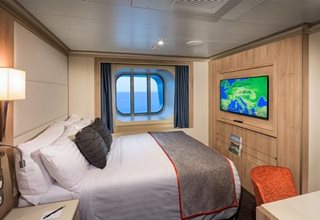
Category: CQ
Amenities- Daily housekeeping
- Complimentary 24-hour room service
- Elemis Aromapure soap, lotion, shampoo
- Luxurious bathrobes
- Hair dryers, makeup mirrors
- Fresh fruit upon request
- Safe
- Ice service
- Shoeshine
- TV with On Demand movies, programming
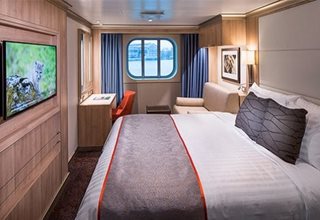
Category: C
Amenities- Daily housekeeping
- Complimentary 24-hour room service
- Elemis Aromapure soap, lotion, shampoo
- Luxurious bathrobes
- Hair dryers, makeup mirrors
- Fresh fruit upon request
- Safe
- Ice service
- Shoeshine
- TV with On Demand movies, programming

Category: D
Amenities- Daily housekeeping
- Complimentary 24-hour room service
- Elemis Aromapure soap, lotion, shampoo
- Luxurious bathrobes
- Hair dryers, makeup mirrors
- Fresh fruit upon request
- Safe
- Ice service
- Shoeshine
- TV with On Demand movies, programming

Category: E
Amenities- Daily housekeeping
- Complimentary 24-hour room service
- Elemis Aromapure soap, lotion, shampoo
- Luxurious bathrobes
- Hair dryers, makeup mirrors
- Fresh fruit upon request
- Safe
- Ice service
- Shoeshine
- TV with On Demand movies, programming

Category: F
Amenities- Daily housekeeping
- Complimentary 24-hour room service
- Elemis Aromapure soap, lotion, shampoo
- Luxurious bathrobes
- Hair dryers, makeup mirrors
- Fresh fruit upon request
- Safe
- Ice service
- Shoeshine
- TV with On Demand movies, programming
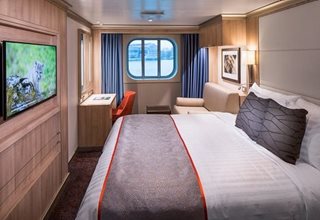
Category: OO
Amenities- Daily housekeeping
- Complimentary 24-hour room service
- Elemis Aromapure soap, lotion, shampoo
- Luxurious bathrobes
- Hair dryers, makeup mirrors
- Fresh fruit upon request
- Safe
- Ice service
- Shoeshine
- TV with On Demand movies, programming
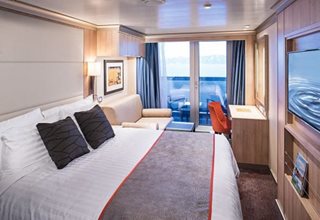
Category: VQ
Amenities- Daily housekeeping
- Complimentary 24-hour room service
- Elemis Aromapure soap, lotion, shampoo
- Luxurious bathrobes
- Hair dryers, makeup mirrors
- Fresh fruit upon request
- Safe
- Ice service
- Shoeshine
- TV with On Demand movies, programming

Category: VS
Amenities- Daily housekeeping
- Complimentary 24-hour room service
- Elemis Aromapure soap, lotion, shampoo
- Luxurious bathrobes
- Hair dryers, makeup mirrors
- Fresh fruit upon request
- Safe
- Ice service
- Shoeshine
- TV with On Demand movies, programming

Category: V
Amenities- Daily housekeeping
- Complimentary 24-hour room service
- Elemis Aromapure soap, lotion, shampoo
- Luxurious bathrobes
- Hair dryers, makeup mirrors
- Fresh fruit upon request
- Safe
- Ice service
- Shoeshine
- TV with On Demand movies, programming

Category: VA
Amenities- Daily housekeeping
- Complimentary 24-hour room service
- Elemis Aromapure soap, lotion, shampoo
- Luxurious bathrobes
- Hair dryers, makeup mirrors
- Fresh fruit upon request
- Safe
- Ice service
- Shoeshine
- TV with On Demand movies, programming

Category: VB
Amenities- Daily housekeeping
- Complimentary 24-hour room service
- Elemis Aromapure soap, lotion, shampoo
- Luxurious bathrobes
- Hair dryers, makeup mirrors
- Fresh fruit upon request
- Safe
- Ice service
- Shoeshine
- TV with On Demand movies, programming

Category: VC
Amenities- Daily housekeeping
- Complimentary 24-hour room service
- Elemis Aromapure soap, lotion, shampoo
- Luxurious bathrobes
- Hair dryers, makeup mirrors
- Fresh fruit upon request
- Safe
- Ice service
- Shoeshine
- TV with On Demand movies, programming

Category: VD
Amenities- Daily housekeeping
- Complimentary 24-hour room service
- Elemis Aromapure soap, lotion, shampoo
- Luxurious bathrobes
- Hair dryers, makeup mirrors
- Fresh fruit upon request
- Safe
- Ice service
- Shoeshine
- TV with On Demand movies, programming

Category: VE
Amenities- Daily housekeeping
- Complimentary 24-hour room service
- Elemis Aromapure soap, lotion, shampoo
- Luxurious bathrobes
- Hair dryers, makeup mirrors
- Fresh fruit upon request
- Safe
- Ice service
- Shoeshine
- TV with On Demand movies, programming

Category: VF
Amenities- Daily housekeeping
- Complimentary 24-hour room service
- Elemis Aromapure soap, lotion, shampoo
- Luxurious bathrobes
- Hair dryers, makeup mirrors
- Fresh fruit upon request
- Safe
- Ice service
- Shoeshine
- TV with On Demand movies, programming

Category: VH
Amenities- Daily housekeeping
- Complimentary 24-hour room service
- Elemis Aromapure soap, lotion, shampoo
- Luxurious bathrobes
- Hair dryers, makeup mirrors
- Fresh fruit upon request
- Safe
- Ice service
- Shoeshine
- TV with On Demand movies, programming
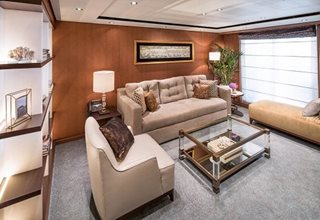
Category: PS
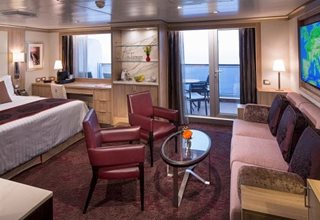
Category: SQ
Amenities- Daily housekeeping
- Complimentary 24-hour room service
- Elemis Aromapure soap, lotion, shampoo
- Premium bathrobes, slippers
- Hair dryers, makeup mirrors
- Fresh fruit upon request
- Safe
- Ice service
- Shoeshine
- TV with On Demand movies, programming
- Fresh flowers
- One-Touch concierge service
- Whirlpool bath (suite dependent)
- In-suite coffee, espresso
- Complimentary laundry
- Pre-dinner hors d'oeuvres served in suite
- Welcome glass of sparkling wine
- Priority boarding for tender ports, priority dining/seating requests, special disembarkation service
- High tea in suite on request
- Binoculars
- Exclusive tote bag

Category: SA
Amenities- Daily housekeeping
- Complimentary 24-hour room service
- Elemis Aromapure soap, lotion, shampoo
- Premium bathrobes, slippers
- Hair dryers, makeup mirrors
- Fresh fruit upon request
- Safe
- Ice service
- Shoeshine
- TV with On Demand movies, programming
- Fresh flowers
- One-Touch concierge service
- Whirlpool bath (suite dependent)
- In-suite coffee, espresso
- Complimentary laundry
- Pre-dinner hors d'oeuvres served in suite
- Welcome glass of sparkling wine
- Priority boarding for tender ports, priority dining/seating requests, special disembarkation service
- High tea in suite on request
- Binoculars
- Exclusive tote bag

Category: SB
Amenities- Daily housekeeping
- Complimentary 24-hour room service
- Elemis Aromapure soap, lotion, shampoo
- Premium bathrobes, slippers
- Hair dryers, makeup mirrors
- Fresh fruit upon request
- Safe
- Ice service
- Shoeshine
- TV with On Demand movies, programming
- Fresh flowers
- One-Touch concierge service
- Whirlpool bath (suite dependent)
- In-suite coffee, espresso
- Complimentary laundry
- Pre-dinner hors d'oeuvres served in suite
- Welcome glass of sparkling wine
- Priority boarding for tender ports, priority dining/seating requests, special disembarkation service
- High tea in suite on request
- Binoculars
- Exclusive tote bag

Category: SC
Amenities- Daily housekeeping
- Complimentary 24-hour room service
- Elemis Aromapure soap, lotion, shampoo
- Premium bathrobes, slippers
- Hair dryers, makeup mirrors
- Fresh fruit upon request
- Safe
- Ice service
- Shoeshine
- TV with On Demand movies, programming
- Fresh flowers
- One-Touch concierge service
- Whirlpool bath (suite dependent)
- In-suite coffee, espresso
- Complimentary laundry
- Pre-dinner hors d'oeuvres served in suite
- Welcome glass of sparkling wine
- Priority boarding for tender ports, priority dining/seating requests, special disembarkation service
- High tea in suite on request
- Binoculars
- Exclusive tote bag
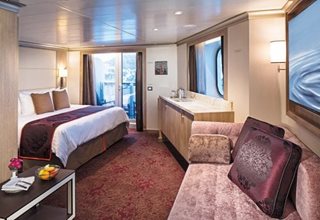
Category: SS
Amenities- Daily housekeeping
- Complimentary 24-hour room service
- Elemis Aromapure soap, lotion, shampoo
- Luxurious bathrobes
- Hair dryers, makeup mirrors
- Generous storage
- Fresh fruit upon request
- Safe
- Ice service
- Shoeshine
- TV with On Demand movies, programming
- Binoculars

Category: SY
Amenities- Daily housekeeping
- Complimentary 24-hour room service
- Elemis Aromapure soap, lotion, shampoo
- Luxurious bathrobes
- Hair dryers, makeup mirrors
- Generous storage
- Fresh fruit upon request
- Safe
- Ice service
- Shoeshine
- TV with On Demand movies, programming
- Binoculars
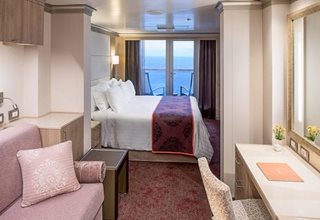
Category: AS
Amenities- Daily housekeeping
- Complimentary 24-hour room service
- Elemis Aromapure soap, lotion, shampoo
- Luxurious bathrobes
- Hair dryers, makeup mirrors
- Generous storage
- Fresh fruit upon request
- Safe
- Ice service
- Shoeshine
- TV with On Demand movies, programming
- Binoculars

Category: A
Amenities- Daily housekeeping
- Complimentary 24-hour room service
- Elemis Aromapure soap, lotion, shampoo
- Luxurious bathrobes
- Hair dryers, makeup mirrors
- Generous storage
- Fresh fruit upon request
- Safe
- Ice service
- Shoeshine
- TV with On Demand movies, programming
- Binoculars

Category: B
Amenities- Daily housekeeping
- Complimentary 24-hour room service
- Elemis Aromapure soap, lotion, shampoo
- Luxurious bathrobes
- Hair dryers, makeup mirrors
- Generous storage
- Fresh fruit upon request
- Safe
- Ice service
- Shoeshine
- TV with On Demand movies, programming
- Binoculars

Category: BC
Amenities- Daily housekeeping
- Complimentary 24-hour room service
- Elemis Aromapure soap, lotion, shampoo
- Luxurious bathrobes
- Hair dryers, makeup mirrors
- Generous storage
- Fresh fruit upon request
- Safe
- Ice service
- Shoeshine
- TV with On Demand movies, programming
- Binoculars
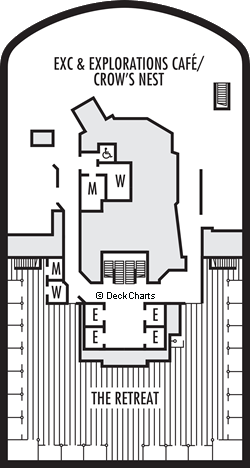
| Symbol | Description |
|---|---|
 | Quad (2 lower beds, 1 sofa bed, 1 upper) |
 | Triple (2 lower beds, 1 upper) |
 | Triple (2 lower beds, 1 sofa bed) |
 | Double (2 lower beds convertible to 1 king-size bed, no Murphy bed) |
 | Partially obstructed view |
 | Connecting rooms |
 | Floor-to-ceiling windows |
 | Shower only |
 | Uncovered verandah |
 | Staterooms have solid steel verandah railings instead of clear-view plexiglass railings |
 | Fully accessible, roll-in shower only |
 | Ambulatory accessible, shower only with small step, step into bathroom, standard interior and exterior door size |
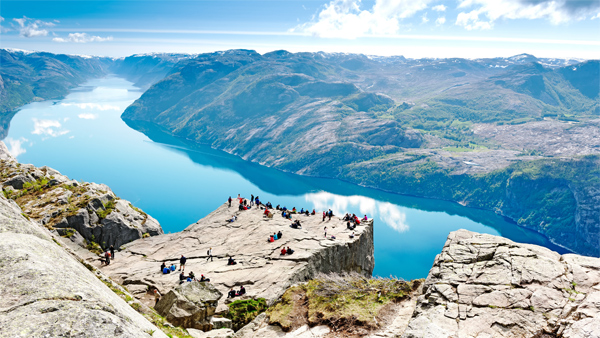
- Ship Name: Nieuw Statendam
- Year Built: 2017
- Year Entered Present Fleet: 2018
- Ship Class: Pinnacle
- Maximum Capacity: 2,666
- Number of Passenger Decks: 13
- Number of Crew: 1,036
- Officers' Nationality: International
- Tonnage (GRT): 99,500
- Country of Registry: Netherlands
- Crew/Hotel Staff Nationality: International
Costco Member Reviews

Available Dates & Prices
Terms & Conditions
*Price shown is per person based on double occupancy and is valid for select stateroom categories only. Click on the Terms & Conditions link below for details.
†One Digital Costco Shop Card per room/stateroom, per stay. The exact amount of the Digital Costco Shop Card will be calculated during the booking process. The Digital Costco Shop Card promotion is nontransferable and may not be combined with any other promotion. A Digital Costco Shop Card will arrive by email approximately 10 days after the start of your cruise. Click on the Terms & Conditions link below for additional information
Ship's registry: The Netherlands
Digital Costco Shop Card
Book this vacation or cruise with Costco Travel and receive a Digital Costco Shop Card. The Digital Costco Shop Card is a convenient payment option in our warehouses and on Costco.ca.






























